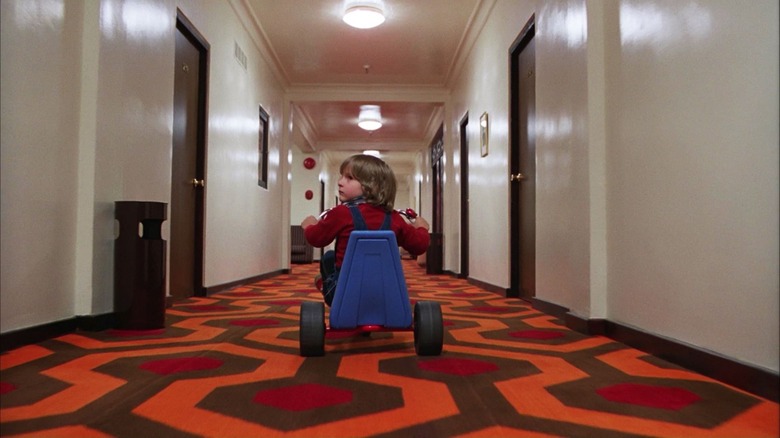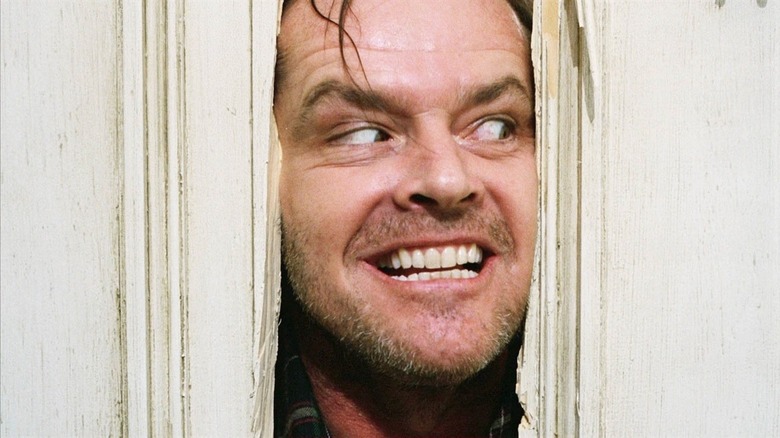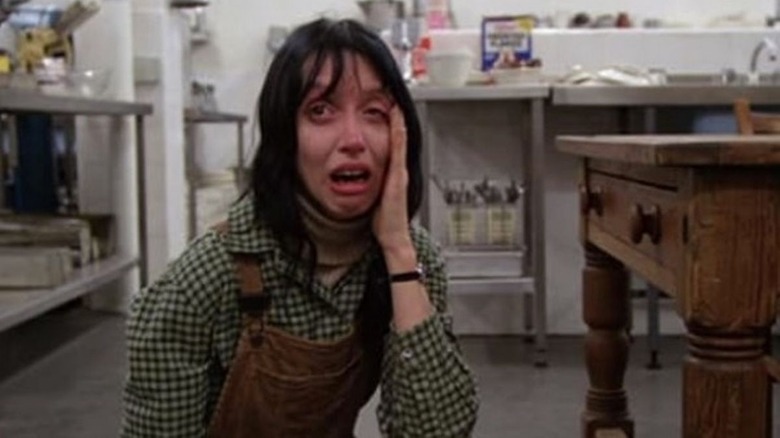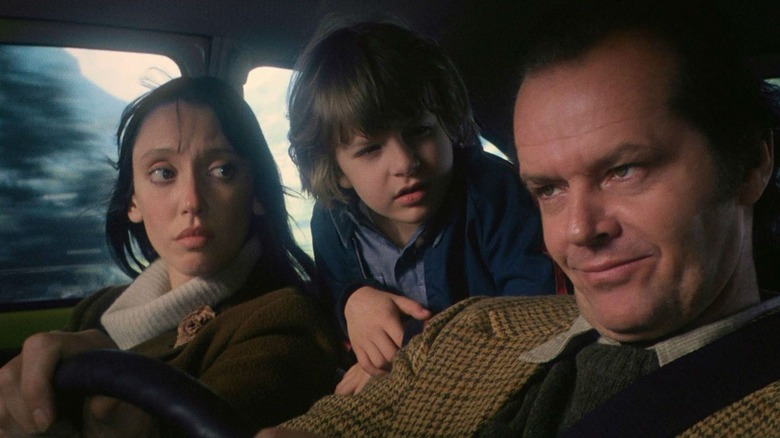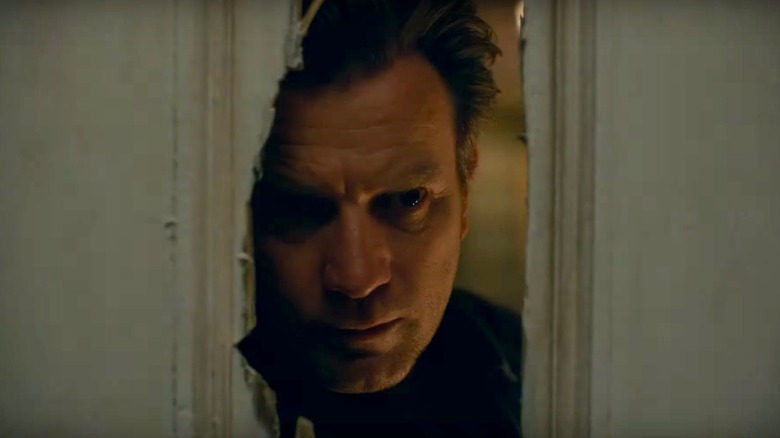Why Stephen King Hated Stanley Kubrick's Adaptation Of The Shining So Much
If you ask a horror fan to name the top 10 best horror movies of all time, more often than not, Stanley Kubrick's "The Shining" will make an appearance. The 1980 film adaptation of Stephen King's novel of the same name is largely considered to be a cinematic horror masterpiece, and in 2018, "The Shining" was selected for preservation in the United States National Film Registry by the Library of Congress as being "culturally, historically, or aesthetically significant." The film has completely permeated culture as a whole, where even people who've never actually seen the film can identify moments like "Red Rum," The Grady twins standing in the hallway, and Jack Nicholson's now iconic delivery of "Heeeere's Johnny!" The film has enjoyed an over 40-year reign as one of the scariest movies ever made, but if you ask "The Shining" writer Stephen King, these accolades are undeserved.
From the very beginning of production, Stephen King was very vocal regarding his disappointment with Kubrick's filmmaking decisions. Rather than deliver a faithful adaptation of King's work, Kubrick made "The Shining" his own, going against the wishes and artistic intent of King, and deviating from his original story. In the years since the release of "The Shining," King has spoken ad nauseum regarding his distaste for the movie, even encouraging him to write and produce the Mick Garris directed mini-series "Stephen King's The Shining," in the wake of his dissatisfaction with Kubrick's movie. Why does Stephen King hate Kubrick's movie so much? Let's take a visit to the Overlook Hotel and break it all down.
Stephen King hated the casting of Jack Nicholson
Despite an incomparable career, Jack Nicholson's portrayal of Jack Torrance in "The Shining" is arguably his most recognizable. In King's novel, Jack is introduced as a well-intentioned and likable man, still struggling to overcome his history of alcoholism and a general dislike for authority. Upon entering The Overlook Hotel, Jack quickly becomes overtaken by the evil within its walls, possessing him and destroying everything inside his mind that kept him human. In Kubrick's film, Torrance is presented as a sinister presence almost immediately. Frederick Clarke of Cinefantastique magazine in 1996 described the change as, "Instead of playing a normal man who becomes insane, Nicholson portrays a crazy man attempting to remain sane."
"The character of Jack Torrance has no arc in that movie ...absolutely no arc at all," King said. In a chat with Deadline (via IndieWire), King elaborated:
"When we first see Jack Nicholson, he's in the office of Mr. Ullman, the manager of the hotel, and you know, then, he's crazy as a s*** house rat. All he does is get crazier. In the book, he's a guy who's struggling with his sanity and finally loses it. To me, that's a tragedy. In the movie, there's no tragedy because there's no real change."
From the moment King heard Kubrick was looking at Nicholson for the role, he disavowed the casting. According to the book "Fright Favorites: 31 Movies to Haunt Your Halloween and Beyond," King had suggested actors Michael Moriarty, Jon Voight, and Martin Sheen, who he felt would better represent the character he had written. Kubrick was looking at Nicholson, Robert De Niro, Harrison Ford, and Robin Williams.
Kubrick completely changed Wendy Torrance (and Shelley Duvall)
Jack Torrance wasn't the only character to be overhauled by Kubrick, Wendy Torrance's film adaptation was also dramatically changed. Kubrick's version of Wendy Torrance portrays her as frail, emotionally weak, submissive, and vulnerable, casting Shelley Duvall fresh off the heels of her roles in "3 Women" and "Annie Hall." Unfortunately, Kubrick's decision to make Wendy Torrance appear weaker than King's character in the book had a permanent impact on Duvall, who Kubrick psychologically tormented on set to get the performance out of her he desired. The famous scene of Wendy backing away from Jack on the stairs was shot a record number 127 takes, shredding Duvall's hands raw from gripping a baseball bat and suffering from dehydration from crying.
King has been vocally critical of the change, calling Duvall's characterization of Wendy as "one of the most misogynistic characters ever put on film." The author added, "She's basically just there to scream and be stupid, and that's not the woman that I wrote about." King has created some of the best female characters in horror history, and it's a shame that the true character of Wendy Torrance has been lost in the eyes of the general public. Even so, Duvall's character is the definitive version from a pop culture standpoint, regardless of how King's book originally presented her.
King and Kubrick fundamentally disagree on what makes horror
In the TCM documentary "A Night At The Movies: The Horrors of Stephen King," King mentioned a phone call he had with Kubrick regarding ghost stories and the possibilities of life after death. Kubrick told King that there's a fundamental sense of optimism with ghost stories, because they imply an existence after death. King responded asking if he found hell to be optimistic, and Kubrick stated that he doesn't believe in hell. Right away, this is the basis for the disconnect between King and Kubrick's visions of horror. King's view of good and evil is rooted in Biblical influences, while Kubrick was a known pessimist. These differing views on what makes something good or evil is a direct influence on their differing beliefs regarding Jack Torrance.
"I think 'The Shining' is a beautiful film and it looks terrific and as I've said before, it's like a big, beautiful Cadillac with no engine inside it," King said a few years back. "In that sense, when it opened, a lot of the reviews weren't very favorable, and I was one of those reviewers ... I kept my mouth shut at the time, but I didn't care for it much."
King has definitely opened his mouth in the years since, unafraid to express how he really feels. "The movie has no heart; there's no center to the picture," he said. "I wrote the book as a tragedy, and if it was a tragedy, it was because all the people loved each other ... here, it seems there's no tragedy because there's nothing to be lost."
Doctor Sleep changed Kubrick's Shining for Stephen King
36 years after King published "The Shining," he released the sequel novel, "Doctor Sleep." Focused on a now adult Danny Torrance (Ewan McGregor), contemporary master of horror Mike Flanagan was tasked with the impossible a few years later when directing the film adaptation — the need to marry the undeniable iconography of Kubrick's "The Shining" with the artistic intent of Stephen King. When Flanagan was chosen for the job, he was honest with King and told him, "If you say 'Overlook Hotel,' I see something. It lives right up in my brain because of Stanley Kubrick ... you can't pretend that isn't the case." Admittedly reluctant, King was eventually won over by Flanagan's screenplay, going so far as to say, "Everything that I ever disliked about the Kubrick version of 'The Shining' is redeemed for me here."
King saw the finished project for the first time in an empty theater with Flanagan, who told him he did "a beautiful job" once the credits rolled. As Flanagan tells it, in the conversations that followed, King told him that "Doctor Sleep" actually helped warm his feelings toward Kubrick's version of "The Shining." King said:
"Mike took my material, he created a terrific story, people who have seen this movie flip for it, and I flipped for it, too. He managed to take my novel of 'Doctor Sleep,' the sequel, and somehow weld it seamlessly to the Kubrick version of 'The Shining,' the movie. So, yeah, I liked it a lot."
Thanks to Mike Flanagan, the impossible was made possible, and the legendary strife between Stephen King and Stanley Kubrick's ideas of "The Shining" was made a bit sweeter.
